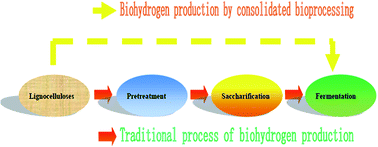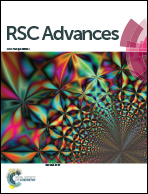Direct hydrogen production from lignocellulose by the newly isolated Thermoanaerobacterium thermosaccharolyticum strain DD32†
Abstract
Biofuel from lignocellulosic materials is a promising type of fuel because it does not compete with food supplies and has a sustainable production process. However, the primary obstacle for producing biofuels from lignocellulose is the low-energy productivity of microorganisms. In this research, thermophilic bacterial strain DD32, which effectively converts lignocellulose to hydrogen, was isolated and characterized. This strain was identified as Thermoanaerobacterium thermosaccharolyticum according to 16S rRNA sequence homology. The maximum H2 production yield reached 12.08 mmol H2 g−1 Avicel, which is equivalent to 2.17 mol H2 mol−1 glucose, at the optimal condition of 55 °C and pH 7.5 with 5.0 g L−1 Avicel. To our knowledge, this result represents the highest H2 yield from cellulose for thermophilic bacterial monocultures reported so far. Moreover, the hydrogen productivity of strain DD32 from raw (non-pretreated) lignocellulosic biomass is also tested. Results show that the highest hydrogen yield and lignocelluloses degradation rate reached 6.38 mmol H2 g−1 and 44.29% from corn stalk after 72 h of incubation. This yield was almost 2–3 times that of other thermophilic strains. These results suggested that newly isolate T. thermosaccharolyticum DD32 could serve as an effective microbial catalyst for lignocellulosic hydrogen production.


 Please wait while we load your content...
Please wait while we load your content...